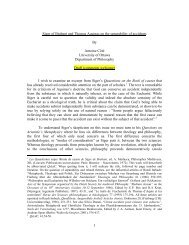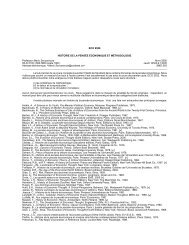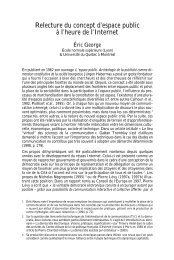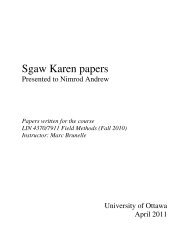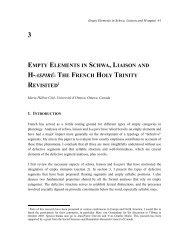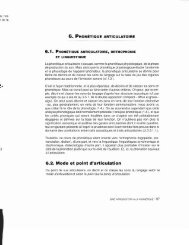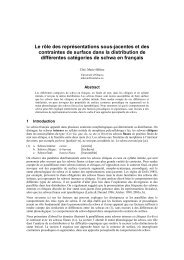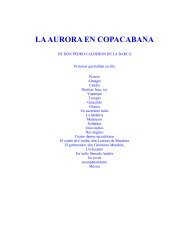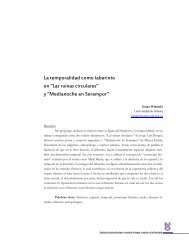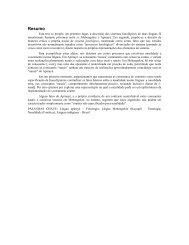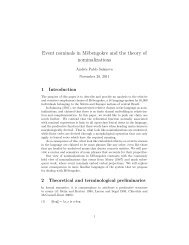8. Multi-Factor Designs
8. Multi-Factor Designs
8. Multi-Factor Designs
You also want an ePaper? Increase the reach of your titles
YUMPU automatically turns print PDFs into web optimized ePapers that Google loves.
<strong>8.</strong> <strong>Multi</strong>-<strong>Factor</strong> <strong>Designs</strong><br />
Chapter <strong>8.</strong> Experimental Design II: <strong>Factor</strong>ial <strong>Designs</strong><br />
1
Goals<br />
• Identify, describe and create multifactor<br />
(a.k.a. “factorial”) designs<br />
• Identify and interpret main effects and<br />
interaction effects<br />
• Calculate N for a given factorial design<br />
2
Complexity and Design<br />
• As experimental designs increase in complexity:<br />
• More information can be obtained.<br />
• Care in design becomes ever more important.<br />
• <strong>Designs</strong> with multiple factors and levels:<br />
• Allow detection of interaction effects<br />
• Allow detection of non-linear effects<br />
• Involve more complexity around potential sequence<br />
effects and equivalent groups problems<br />
3
<strong>8.</strong>1 Describing<br />
<strong>Multi</strong>-<strong>Factor</strong> <strong>Designs</strong><br />
4
<strong>Multi</strong>-<strong>Factor</strong> <strong>Designs</strong><br />
• Have more than one IV (or factor). a.k.a. “factorial<br />
design”<br />
• Described by a numbering system that gives the<br />
number of levels of each IV<br />
Examples: “2 × 2” or “3 × 4 × 2” design<br />
• Also described by factorial matrices<br />
5
Numbering System for<br />
<strong>Factor</strong>ial <strong>Designs</strong><br />
• Number of digits = number of IVs:<br />
• “3 × 3” or “5 × 2” means two IVs.<br />
• “2 × 2 × 2” or “3 × 4 × 2” means three IVs.<br />
• Value of each digit = # of levels in each IV:<br />
• 3 × 3 means two IVs, each with three levels.<br />
• 3 × 4 × 2 means three IVs with 3, 4 and 2<br />
levels, respectively<br />
6
2 x 2 <strong>Factor</strong>ial Design<br />
Psychotherapy<br />
Drug Therapy<br />
Placebo Prozac<br />
None Control Prozac<br />
CBT CBT<br />
7<br />
Combined<br />
Therapy
2 x 3 <strong>Factor</strong>ial Design<br />
Psychotherapy<br />
Drug Therapy<br />
Placebo Prozac<br />
None Control Prozac<br />
CBT CBT<br />
EFT EFT<br />
8<br />
CBT +<br />
Prozac<br />
EFT +<br />
Prozac
Levels vs. Conditions<br />
• Level: One level of one IV.<br />
A row or column in the <strong>Factor</strong>ial Matrix.<br />
Also, for 3+ IVs, one of the sub-matrices<br />
• Condition: A particular combination of one<br />
level of each IV.<br />
One cell in the <strong>Factor</strong>ial Matrix.<br />
• In single-factor designs: level = condition<br />
12
Placebo Level of Drug<br />
Therapy IV<br />
Drug Therapy<br />
Placebo Prozac<br />
Psycho-<br />
None Control Prozac<br />
therapy<br />
CBT CBT Combo<br />
13
Prozac Level of Drug<br />
Therapy IV<br />
Drug Therapy<br />
Placebo Prozac<br />
Psycho-<br />
None Control Prozac<br />
therapy<br />
CBT CBT Combo<br />
14
None Level of<br />
Psychotherapy IV<br />
Drug Therapy<br />
Placebo Prozac<br />
Psycho-<br />
None Control Prozac<br />
therapy<br />
CBT CBT Combo<br />
15
CBT Level of<br />
Psychotherapy IV<br />
Drug Therapy<br />
Placebo Prozac<br />
Psycho-<br />
None Control Prozac<br />
therapy<br />
CBT CBT Combo<br />
16
One-factor <strong>Designs</strong><br />
2-level<br />
<strong>Multi</strong>level<br />
Study Time<br />
2 Hours 5 Hours<br />
2<br />
Hours<br />
Study Time<br />
3<br />
Hours<br />
4<br />
Hours<br />
5<br />
Hours<br />
17
Discussion / Questions<br />
• Why are the terms level and factor<br />
interchangeable in a single-factor design?<br />
• How many IVs are there in a 3×2×2 design?<br />
How many levels of each IV? How many<br />
total conditions?<br />
18
<strong>8.</strong>2 Interpreting Data From<br />
<strong>Multi</strong>-<strong>Factor</strong> <strong>Designs</strong><br />
19
Interpreting Data from<br />
<strong>Factor</strong>ial <strong>Designs</strong><br />
• Two types of effects can emerge in multi-factorial<br />
designs:<br />
• Main Effects: When one IV has an effect on its own.<br />
That is, the mean for some pair of levels of the IV<br />
differ significantly from one another.<br />
• Interaction Effects: When the effect of one IV is<br />
different for different levels of another IV.<br />
• These are NOT mutually exclusive<br />
20
A Simple 2x2 Design<br />
Drug Therapy<br />
Placebo Prozac<br />
Psycho-<br />
None Control Prozac<br />
therapy<br />
CBT CBT Combo<br />
21
Main Effect of<br />
Psychotherapy<br />
Psycho-<br />
None<br />
therapy<br />
CBT<br />
Drug Therapy<br />
Placebo Prozac<br />
(Control+ Prozac )<br />
/ 2<br />
(CBT + Combo)<br />
/ 2<br />
We collapse across the levels of all other<br />
IVs to evaluate a main effect<br />
22
Main Effect of Drug Therapy<br />
Psycho-<br />
None<br />
therapy<br />
CBT<br />
Drug Therapy<br />
Placebo Prozac<br />
(Control+<br />
CBT )<br />
/2<br />
(Prozac +<br />
Combo)<br />
/2<br />
We collapse across the levels of all other<br />
IVs to evaluate a main effect<br />
23
Numerical Example<br />
Psychotherapy<br />
Drug Therapy<br />
Placebo Prozac<br />
None 12 ± 2 18 ± 1<br />
CBT 17 ± 1 23 ± 3<br />
24
Main Effect of<br />
Psychotherapy?<br />
Drug Therapy<br />
Placebo Prozac<br />
Psycho-<br />
None (12+18)/2 = 15<br />
therapy<br />
CBT (17+23)/2 (17+23)/2 = 20<br />
25
Main Effect of Drug<br />
Therapy?<br />
Psycho-<br />
None 12+17<br />
2<br />
therapy<br />
CBT 14.5<br />
Drug Therapy<br />
Placebo Prozac<br />
18+23<br />
2<br />
20.5<br />
26
Numerical Example<br />
Drug Therapy<br />
Placebo Prozac µ ∆<br />
Psycho-<br />
None 12 ± 2 18 ± 1 15 -6<br />
therapy<br />
CBT 17 ± 1 23 ± 3 20 -6<br />
µ 14.5 20.5<br />
∆ -5 -5<br />
27
Numerical Example<br />
Drug Therapy<br />
Placebo Prozac µ ∆<br />
Psycho-<br />
None 12 ± 2 18 ± 1 15 -6<br />
therapy<br />
CBT 17 ± 1 30 ± 3 20 -13<br />
µ 14.5 20.5<br />
∆ -5 -12<br />
Evidence of<br />
Interaction<br />
28
Discussion / Questions<br />
• In a 3x3x2 design, how many potential main<br />
effects are there? How many IVs would<br />
you collapse across to evaluate each main<br />
effect?<br />
29
•<br />
•<br />
•<br />
•<br />
Example <strong>Multi</strong>-<strong>Factor</strong>ial<br />
<strong>Multi</strong>-factorial experiments manipulate several IVs to see<br />
if their effects interact<br />
Example Question: Does gender interact with<br />
psychotherapy in affecting depression?<br />
•<br />
•<br />
Two IVs:<br />
Experiment<br />
Gender. 2 Levels = male; female<br />
Psychotherapy. 2 levels: control (none); experimental<br />
(therapy)<br />
One DV: Depression (measure = BDI)<br />
30
!"<br />
#!"<br />
$!"<br />
%!"<br />
&!"<br />
'()*+(,"""""""""""""<br />
-)("*./+0123"<br />
4./+012"<br />
!"#$%&#'()*)+'<br />
,-)./$"'()*)+'<br />
!"<br />
#!"<br />
$!"<br />
%!"<br />
&!"<br />
'()*+(,"""""""""""""<br />
-)("*./+0123"<br />
4./+012"<br />
!"#$%&#'()*)+'<br />
,-)./$"'()*)+'<br />
!"<br />
#!"<br />
$!"<br />
%!"<br />
&!"<br />
'()*+(,"""""""""""""<br />
-)("*./+0123"<br />
4./+012"<br />
!"#$%&#'()*)+'<br />
,-)./$"'()*)+'<br />
!"<br />
#!"<br />
$!"<br />
%!"<br />
&!"<br />
'()*+(,"""""""""""""<br />
-)("*./+0123"<br />
4./+012"<br />
!"#$%&#'()*)+'<br />
,-)./$"'()*)+'<br />
!"<br />
#!"<br />
$!"<br />
%!"<br />
&!"<br />
'()*+(,"""""""""""""<br />
-)("*./+0123"<br />
4./+012"<br />
!"#$%&#'()*)+'<br />
,-)./$"'()*)+'<br />
!"<br />
#!"<br />
$!"<br />
%!"<br />
&!"<br />
'()*+(,"""""""""""""<br />
-)("*./+0123"<br />
4./+012"<br />
!"#$%&#'()*)+'<br />
,-)./$"'()*)+'<br />
!"<br />
#!"<br />
$!"<br />
%!"<br />
&!"<br />
'()*+(,"""""""""""""<br />
-)("*./+0123"<br />
4./+012"<br />
!"#$%&#'()*)+'<br />
,-)./$"'()*)+'<br />
!"<br />
#!"<br />
$!"<br />
%!"<br />
&!"<br />
'()*+(,"""""""""""""<br />
-)("*./+0123"<br />
4./+012"<br />
!"#$%&#'()*)+'<br />
,-)./$"'()*)+'<br />
31
Another 2-<strong>Factor</strong> Design, 3 Levels Per <strong>Factor</strong><br />
Task<br />
Difficulty<br />
Easy<br />
Average<br />
Hard<br />
Arousal<br />
Low Med High<br />
Low<br />
Easy<br />
Low<br />
Average<br />
Low<br />
Hard<br />
32<br />
Med<br />
Easy<br />
Med<br />
Average<br />
Med<br />
Hard<br />
High<br />
Easy<br />
High<br />
Average<br />
High<br />
Hard
Another 2-<strong>Factor</strong> Design, 3 Levels Per <strong>Factor</strong><br />
Task<br />
Difficulty<br />
Arousal<br />
Low Med High µ ΔLM ΔMH ΔLH<br />
Easy 40 40 40 40 0 0 0<br />
Avrge 15 30 15 20 15 -15 0<br />
Hard 8 5 2 5 -3 -3 -6<br />
µ 21 25 19<br />
ΔEA -25 -10 -25<br />
ΔAH -7 -25 -13<br />
ΔEH -32 -35 -38<br />
33
!"#$%#&'()"*<br />
Results: 3x3 Design<br />
'!"<br />
&!"<br />
%!"<br />
$!"<br />
#!"<br />
!"<br />
()*" +,-./0" 1.23"<br />
+#%,-'.*<br />
34<br />
4567"<br />
89,:52,"<br />
15:-"
3x3 Results: Main Effects, No Interaction<br />
Task<br />
Difficult<br />
y<br />
Arousal<br />
Low Med High µ ΔL<br />
M<br />
ΔM<br />
H<br />
ΔLH<br />
Easy 30 40 50 40 10 10 20<br />
Avrge 15 25 35 25 10 10 20<br />
Hard 6 16 26 16 10 10 20<br />
µ 17 27 37<br />
ΔEA -15 -15 -15<br />
ΔAH -9 -9 -9<br />
ΔEH -24 -24 -24<br />
35
3x3 Results: 2 Main Effects,<br />
!"#$%#&'()"*<br />
(!"<br />
'!"<br />
&!"<br />
%!"<br />
$!"<br />
#!"<br />
!"<br />
No Interaction<br />
)*+" ,-./01" 2/34"<br />
+#%,-'.*<br />
36<br />
5678"<br />
9:-;63-"<br />
26;."
Interpreting Data from<br />
<strong>Factor</strong>ial <strong>Designs</strong><br />
• If one IV has an effect--that is, there’s a significant<br />
effect of going from one level of that IV to<br />
another, while ignoring (“collapsing across”) all<br />
other IVs--then that IV is said to produce a “main<br />
effect”.<br />
• If the effect of one IV differs depending on the<br />
level of another IV, there’s an interaction.<br />
37
!"<br />
#!"<br />
$!"<br />
%!"<br />
&!"<br />
'()*+(,"""""""""""""<br />
-)("*./+0123"<br />
4./+012"<br />
!"#$%&#'()*)+'<br />
,-)./$"'()*)+'<br />
!"<br />
#!"<br />
$!"<br />
%!"<br />
&!"<br />
'!"<br />
()*+,)-"""""""""""""<br />
.*)"+/0,1234"<br />
5/0,123"<br />
!"#$%&#'()*)+'<br />
,-)./$"'()*)+'<br />
!"<br />
#!"<br />
$!"<br />
%!"<br />
&!"<br />
'()*+(,"""""""""""""<br />
-)("*./+0123"<br />
4./+012"<br />
!"#$%&#'()*)+'<br />
,-)./$"'()*)+'<br />
!"<br />
#!"<br />
$!"<br />
%!"<br />
&!"<br />
'()*+(,"""""""""""""<br />
-)("*./+0123"<br />
4./+012"<br />
!"#$%&#'()*)+'<br />
,-)./$"'()*)+'<br />
!"<br />
#!"<br />
$!"<br />
%!"<br />
&!"<br />
'()*+(,"""""""""""""<br />
-)("*./+0123"<br />
4./+012"<br />
!"#$%&#'()*)+'<br />
,-)./$"'()*)+'<br />
!"<br />
#!"<br />
$!"<br />
%!"<br />
&!"<br />
'()*+(,"""""""""""""<br />
-)("*./+0123"<br />
4./+012"<br />
!"#$%&#'()*)+'<br />
,-)./$"'()*)+'<br />
!"<br />
#!"<br />
$!"<br />
%!"<br />
&!"<br />
'()*+(,"""""""""""""<br />
-)("*./+0123"<br />
4./+012"<br />
!"#$%&#'()*)+'<br />
,-)./$"'()*)+'<br />
!"<br />
#!"<br />
$!"<br />
%!"<br />
&!"<br />
'()*+(,"""""""""""""<br />
-)("*./+0123"<br />
4./+012"<br />
!"#$%&#'()*)+'<br />
,-)./$"'()*)+'<br />
38
•<br />
•<br />
The Importance of<br />
Interactions<br />
Interpretation of interaction fx<br />
overrides interpretation of main fx<br />
Example: What’s most important in<br />
these results:<br />
Main effect of gender?<br />
Main effect of therapy?<br />
Interaction of the two?<br />
39<br />
!"#$%&#'()*)+'<br />
&!"<br />
%!"<br />
$!"<br />
#!"<br />
!"<br />
'()*+(,""""""""""""" 4./+012"<br />
-)("*./+0123"<br />
,-)./$"'()*)+'<br />
If the gender factor is ignored, the therapy<br />
seems to simply be effective for all people.<br />
But this is not true. It is effective for<br />
females only.
X-Way Interactions<br />
• When there are 2 IVs, a 2-way interaction<br />
is possible,with 3 IVs, may have a 3-way<br />
interaction, etc.<br />
• 3-way interaction means the 2-way<br />
interaction changes depending on a 3rd<br />
variable.<br />
40
!"<br />
#!"<br />
$!"<br />
%!"<br />
&!"<br />
'()*+(,"""""""""""""<br />
-)("*./+0123"<br />
4./+012"<br />
!"#$%&#'()*)+'<br />
,-)./$"'()*)+'<br />
!"<br />
#!"<br />
$!"<br />
%!"<br />
&!"<br />
'()*+(,"""""""""""""<br />
-)("*./+0123"<br />
4./+012"<br />
!"#$%&#'()*)+'<br />
,-)./$"'()*)+'<br />
!"<br />
#!"<br />
$!"<br />
%!"<br />
&!"<br />
'()*+(,"""""""""""""<br />
-)("*./+0123"<br />
4./+012"<br />
!"#$%&#'()*)+'<br />
,-)./$"'()*)+'<br />
!"<br />
#!"<br />
$!"<br />
%!"<br />
&!"<br />
'()*+(,"""""""""""""<br />
-)("*./+0123"<br />
4./+012"<br />
!"#$%&#'()*)+'<br />
,-)./$"'()*)+'<br />
!"<br />
#!"<br />
$!"<br />
%!"<br />
&!"<br />
'()*+(,"""""""""""""<br />
-)("*./+0123"<br />
4./+012"<br />
!"#$%&#'()*)+'<br />
,-)./$"'()*)+'<br />
!"<br />
#!"<br />
$!"<br />
%!"<br />
&!"<br />
'()*+(,"""""""""""""<br />
-)("*./+0123"<br />
4./+012"<br />
!"#$%&#'()*)+'<br />
,-)./$"'()*)+'<br />
Introverts Extroverts<br />
Introverts Extroverts<br />
Introverts Extroverts<br />
41
Discussion / Questions<br />
42
<strong>8.</strong>3 Mixed <strong>Multi</strong>-<strong>Factor</strong><br />
<strong>Designs</strong><br />
43
All Participants (N = 20)<br />
Condition 1<br />
(n = 10)<br />
Review:<br />
Between-Subjects Design<br />
Condition 2<br />
(n = 10)<br />
44
All Participants (N=10)<br />
Level 1 (N = 10)<br />
Level 2 (N = 10)<br />
Review:<br />
Within-Subjects Design<br />
45
Within, Between & Mixed<br />
<strong>Multi</strong>-<strong>Factor</strong> <strong>Designs</strong><br />
• With multiple factors/IVs, one can mix different kinds<br />
of variables (within/between; subject/manipulated,<br />
etc.)<br />
• If all IVs are within-subjects then the design is “fully<br />
within”<br />
• If all IVs are between-subjects then the design is “fully<br />
between”<br />
• Otherwise, it’s a “mixed” design<br />
46
2x2 Fully<br />
Between<br />
Subjects<br />
Design<br />
All Participants (N = 20)<br />
Condition A1B1<br />
(n=5)<br />
Condition A2B1<br />
(n=5)<br />
Condition A1B2<br />
(n=5)<br />
Condition A2B2<br />
(n=5)<br />
47
2x2 Fully<br />
Within<br />
Subjects<br />
Design<br />
Note that orders are not<br />
shown, there would be 24 for<br />
a fully-counterbalanced<br />
design!<br />
All Participants (n = 20)<br />
Condition A1B1<br />
(n = 20)<br />
Condition A2B1<br />
(n = 20)<br />
Condition A1B2<br />
(n = 20)<br />
Condition A2B2<br />
(n = 20)<br />
48
Level B1 (10) All Participants (20) Level B2 (10)<br />
A1B1<br />
(10)<br />
A2B1<br />
(10)<br />
2x2 Mixed Design<br />
A1B2<br />
(10)<br />
A2B2<br />
(10)<br />
49
Fully Within-Subjects<br />
<strong>Factor</strong>ial Design<br />
• a.k.a., Repeated-measures factorial design.<br />
• All subjects are run through all conditions (i.e., all<br />
cells of the factorial matrix).<br />
• Same advantages/disadvantages as single-factor<br />
repeated measures design<br />
50
Example Experiment 1:<br />
Fully Within-Subjects<br />
• Question: Is face recognition more impaired<br />
by inversion than object recognition?<br />
• Method<br />
• Subjects are 20 undergraduates<br />
• Materials are pictures of 25 famous faces<br />
and 25 common objects, either inverted or<br />
not. (So 100 images in all).<br />
51
Example Experiment 1<br />
• Design: 2x2 Fully within-subjects factorial, with<br />
factors being Type of Image (Face or Object)<br />
and View (upright or inverted).<br />
• Procedure: All 20 subjects are shown all 100<br />
images several times in random order and asked<br />
to identify each as quickly as possible.<br />
Repeated-measures factorial design.<br />
• DV is reaction time to name picture.<br />
52
View<br />
Upright<br />
Inverted<br />
Image Type<br />
Face Object<br />
53
Example Experiment 1<br />
• Expected results: RT will be higher for inverted<br />
images than upright ones (main effect). But this<br />
effect will be greater for faces (interaction).<br />
• Implications: Implies that there’s something<br />
different about how people process faces as<br />
compared to objects<br />
54
!"#$%&'%()*"+,%<br />
Possible Results<br />
)!!"<br />
(!!"<br />
'!!"<br />
&!!"<br />
%!!"<br />
$!!"<br />
#!!"<br />
!"<br />
67849" :;
•<br />
•<br />
•<br />
Fully Between-Subjects<br />
<strong>Factor</strong>ial <strong>Designs</strong><br />
Each subject run through only one condition (i.e.,<br />
one cell of the factorial matrix)<br />
If all IVs are subject variables, you have a<br />
Nonequivalent groups factorial design<br />
If all IVs are manipulated, decide how equivalent<br />
groups are formed:<br />
• Random assignment:<br />
Independent groups factorial design<br />
• Matching:<br />
Matched groups factorial design<br />
56
•<br />
Example Experiment 2:<br />
Fully Between-Subjects<br />
Question: Same as before, “are faces more<br />
affected by inversion than objects?”<br />
• Method<br />
•<br />
•<br />
Subjects are 80 undergraduates (note higher N<br />
than within-Ss design).<br />
Materials: Same as before, 25 pictures of faces,<br />
25 pictures of objects, shown both upright and<br />
inverted.<br />
57
Example Experiment 2<br />
• Design 2×2 fully between-subjects factorial<br />
design. Assign subjects randomly to one of<br />
four groups of 20. Independent groups<br />
factorial design.<br />
• Procedure: Each group sees 25 pictures<br />
(upright faces, inverted face, upright<br />
objects, or inverted objects).<br />
58
View<br />
Upright<br />
Inverted<br />
Image Type<br />
Face Object<br />
59
Discussion / Questions<br />
60
Mixed <strong>Factor</strong>ial <strong>Designs</strong><br />
• At least one IV within-subjects and one<br />
between-subjects.<br />
• Subjects run through all levels of some IVs,<br />
but only single level of other IVs. That is,<br />
each subject goes through one row or<br />
column of the factorial matrix.<br />
• Random assignment, matching,<br />
counterbalancing can all be used.<br />
61
Example Experiment 3:<br />
Mixed <strong>Factor</strong>ial Design<br />
• Question: Is face recognition more impaired by<br />
inversion than object recognition?<br />
• Method<br />
• Subjects are 40 undergraduates (note higher<br />
N than fully within, but lower than fully<br />
between).<br />
• Materials are pictures of 25 famous faces and<br />
25 objects, either inverted or not.<br />
62
Example Experiment 3<br />
• Design: 2x2 Mixed factorial with factors being<br />
Type of Image (face or object, within) and<br />
View (upright or inverted, between)<br />
• Procedure: 20 subjects are shown the 50<br />
inverted images (25 faces and 25 objects),<br />
while 20 other subjects are shown the 50<br />
upright images (25 faces, 25 objects).<br />
63
View<br />
Upright<br />
Inverted<br />
Image Type<br />
Face Object<br />
64
PxE <strong>Factor</strong>ial <strong>Designs</strong><br />
• “Person by Environment”<br />
• Variety of fully-between or mixed factorial<br />
design<br />
• At least one subject IV (person) and at least<br />
one manipulated IV (“environment”)<br />
65
•<br />
Example Experiment 4:<br />
PxE Design<br />
Question: Does the effect of assigned study style<br />
interact with preferred study style?<br />
• Method<br />
• Person IV: Ss assigned to groups based on preferred<br />
study style: Crammers or Distributers. This is a subject<br />
IV<br />
• Enviro IV: Half of subjects in each above group are<br />
assigned to study by cramming or by distributing<br />
study. This is manipulated<br />
66
Assigned Style<br />
(manipulated)<br />
Possible Results<br />
Preferred Style (subject)<br />
Crammer Distributer<br />
Cramming 65 65<br />
Distributing 80 90<br />
67
!"#$%&'"<br />
Possible Results<br />
(""#<br />
'"#<br />
&"#<br />
%"#<br />
$"#<br />
!"#<br />
)*+,,5*1# 0-12*-3425*1#<br />
)*+,,-./# 0-12*-342-./#<br />
()*+,-,."/$*'0)%)*10"<br />
Assigned Study Style<br />
68
Interpreting Results From<br />
PxE <strong>Designs</strong><br />
• Cannot draw causal links for the subject<br />
variables, can draw causal links for the<br />
manipulated (”environment”) variable.<br />
• So a causal link can be established for<br />
assigned style but not preferred style.<br />
• Cannot draw causal links for interaction<br />
effects.<br />
69
Example 2x3x2 Study<br />
Caspi et al., 2007, PNAS, 104 (47), 18860-18865<br />
70
How Many Participants?<br />
• If I need 50 participants per cell in a 2×2<br />
factorial design, what is the total N?<br />
• What if the design is fully within?<br />
• What if the design is mixed?<br />
• Answer the same questions for a 3×2×3<br />
design with 10 participants per cell.<br />
71
•<br />
•<br />
•<br />
Analyzing Data From <strong>Multi</strong>-<br />
<strong>Factor</strong> <strong>Designs</strong><br />
As for multi-level designs, multi-factor designs are generally<br />
analyzed via ANOVA procedures:<br />
•<br />
•<br />
•<br />
Pre-tests for normality and other assumptions<br />
2-way (or X-way) ANOVA/MANOVA/ANCOVA...<br />
Post-hoc tests to examine effects in greater detail<br />
Planned comparison techniques may also be involved<br />
Note that there are no well-established techniques for<br />
dealing with multi-factor ordinal-scale data<br />
72
Discussion / Questions<br />
73
<strong>8.</strong>4 Summary:<br />
Design Complexity<br />
74
Single-<strong>Factor</strong>, 2-Level<br />
Experimental <strong>Designs</strong><br />
• Can’t detect non-linear effects.<br />
• Can’t detect interactions.<br />
• Involve only simple counter-balancing or<br />
simple equivalent groups problems.<br />
75
Single-<strong>Factor</strong>,<br />
<strong>Multi</strong>level <strong>Designs</strong><br />
• Can detect non-linear effects<br />
• Can’t detect interactions<br />
• May involve relatively complex counterbalancing<br />
or equivalent groups problems<br />
76
• <strong>Multi</strong>-factor <strong>Designs</strong><br />
• Can detect interactions and main effects<br />
• Can detect non-linear effects where IVs have ≥<br />
3 levels<br />
•<br />
<strong>Multi</strong>-<strong>Factor</strong> <strong>Designs</strong><br />
May involve both complex counter-balancing<br />
and equivalent groups problems.<br />
77
Conclusion:<br />
Experimental Design<br />
• Experiments and quasi-experiments are just<br />
one way of doing research<br />
• True experiments (not quasi) allow<br />
conclusions about causality<br />
• Next we will turn to observational<br />
research, which is simpler in some ways<br />
78




